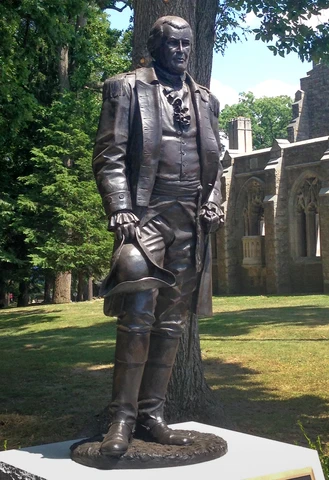“Choosing a Commander” at the Longfellow–Washington Site, 13 Mar.
Two hundred fifty years ago this spring, the Massachusetts Provincial Congress invited the Continental Congress in Philadelphia to take over the direction (and funding) of the army besieging Boston. A big part of that direction was choosing who would command those troops.
Decades later, John Adams left detailed accounts of those discussions. He described himself as the man who advocated for George Washington of Virginia when no one else would.
According to letters Adams wrote in 1815 (and possibly in 1816 but never sent), most Congress delegates preferred either leaving the army in the hands of Gen. Artemas Ward of Massachusetts or hiring former British army lieutenant colonel Charles Lee.
Adams stated:
The Nominations were made, Ward I believe by Mr [Thomas] Cushing, Lee by Mr [Thomas] Mifflin, and Washington by Mr [Thomas] Johnson of Maryland. The opposition to a change was not So warm, as it had been before, but Still each Candidate had his Advocates.In this talk I’ll explore how much the contemporaneous record from 1775, including Adams’s own private letters, supports this recollection.
Nevertheless all agreed in the great importance of Unanimity. This point was urged from all quarters of the House with great force of Reason and Eloquence and Pathos that never has been exceeded in the Counsells of this Nation. It was unanimously agreed to postpone in Election to a future day in hopes that Gentlemen by a deliberate Consideration, laying aside all private feelings, local Attachments, and partial motives, might agree in one, and unanimously determine to Support him with all their Influence. The Choice was accordingly postponed.
By this time all the Friends of Ward, among whom there was not one more Sincere than John Adams who had known him at School within two doors of his Fathers house, and who had known him in Worcester in his riper Years, were fully convinced that Washington Should be preferred to Lee; and they had reason to fear that Delegates from the Southern and Middle States would vote for Lee rather than for any New Englandman. And all the Sober Members would have preferred Either Ward or Washington to Lee.
When the day of Election arrived, after some Observations on the necessity of Concord, Harmony and unanimity in the present portentous moment, Congress proceeded to the Choice and the Suffrages were all found to be for George Washington.
This event is scheduled to start at 6:00 P.M., and will include questions and answers afterward. It is free, but seating in the Longfellow carriage house is limited. There’s an option to watch the livestream, and a recording will be put on the site’s YouTube channel when ready.




.jpg)


.jpg)






